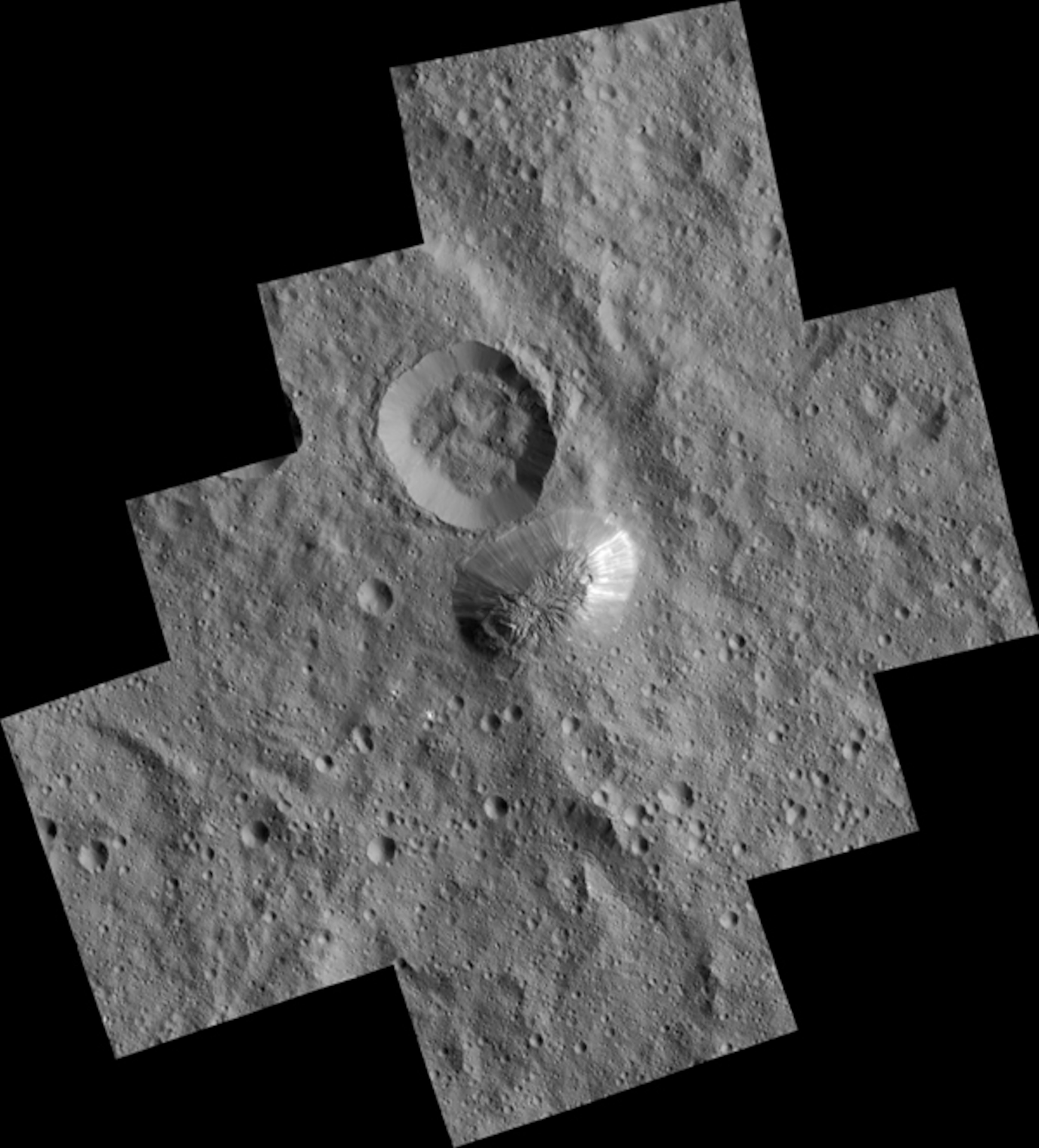
Ceres, the Dwarf Planet Formerly Known as an Ocean World
Update, June 29, 2016: The composition of Ceres’ bright spots is no longer a mystery: Wednesday in Nature, scientists revealed those enigmatic splotches are rich in sodium carbonate, a salt that is tightly linked to watery conditions on Earth. In fact, there’s so much of the stuff in Ceres’ Occator crater that the pit holds the record for the largest such deposit in the solar system aside from Earth.
Just how those salts ended up on Ceres’ surface is still a mystery, though. Instead of containing large amounts of ice, as some scientists had expected, Ceres’ interior is considerably drier than suspected, reports a second study published Wednesday in Nature Geosciencein Nature Geoscience. That makes it hard to explain how the dwarf planet’s surface ended up covered in formerly dissolved salts. Now, researchers are trying to sort out how Ceres made those salts and moved liquid brines to the surface; they suspect impacts may be to blame for simultaneously melting buried ice and excavating the planet’s salty sea, leaving bits of it to shimmer in the sunlight.
THE WOODLANDS, Texas –
Today, Ceres is a salt-covered dwarf planet whose main claim to fame is that it’s the largest body in the main asteroid belt. But back when it was younger and hotter, scientists have found, Ceres was an ocean world—much like the watery moons of Jupiter and Saturn.
“Ceres appears to have been one of these in the past,” Carol Raymond, deputy principal investigator for NASA’s Dawn mission, said Tuesday at the Lunar and Planetary Science Conference. The Dawn mission put a spacecraft in orbit around the tiny planet in March 2015. “What we’re looking at now, we believe, is the remnants of a frozen ocean.”
Scientists hoped that when Dawn arrived at Ceres, it would help solve the mysteries of this strange little world. But instead, Ceres is throwing puzzle after puzzle at the team and proving to be a much tougher space-nut to crack than anticipated.
Among Ceres’ enigmas are those perplexing bright spots, which scientists first thought could be extremely reflective water ice. But closer inspection reveals the spots are likely to be salts – perhaps leftover from a briny, frozen ocean that’s exposed when impacts gouge craters into Ceres’ crust. “We’re interrogating the chemistry, essentially, of that ocean-rock interface,” Raymond said.

The brightest and best-known spots are in Occator crater, a 92-kilometer-wide hole in the ground that is roughly 80 million years old. Occator is covered in vaguely blue, young terrain at its bottom, and shaded somewhat reddish and older around its edges. But it’s the formation on the crater’s floor that has most intrigued scientists: There, among the brightest of the bright spots, is a pit. And rising out of that pit is a fractured, reddish dome.
It’s possible that when Occator formed, the impact not only excavated the crater but heated a portion of the subsurface material enough for ice and other volatiles to waft into space, said Tim Bowling of the University of Chicago. “If you remove all the ice from a region, then you’re able to form a pit,” he said, during a presentation at the meeting. And when that happened, the materials left in the resulting hollow should be the reflective salts.
But how about that dome? Stay tuned. “I just found out yesterday there’s a mound inside the pit,” Bowling said.
It’s no secret that craters are sprinkled across Ceres’ surface. Take a spin around the dwarf planet and multiple pockmarks will fill each frame. But what’s noticeably absent are extremely large craters, the ones more than several hundred kilometers across. These, based on the collisional history of the solar system, should also be carved into Ceres – and yet, they’re missing.
“We must think that those craters formed, and then they got erased,” said Simone Marchi of the Southwest Research Institute. “The question is, How can you erase all those large craters?”

And then there’s that mountain, a pyramidal oddity called Ahuna Mons. About 5 kilometers tall with steep, bluish slopes, Ahuna Mons looks as though it has been thrust straight out of Ceres. “The mountain is really coming out from the subsurface and taking the surface features, which are a little bit older, up the mountain,” said Ralf Jaumann of the German Aerospace Center. It’s not the only mountain on Ceres, he said, but the others are older and less developed.
Those are just a few of the Cererean enigmas scientists are trying to solve. It’s also possible the world is still alive and venting water vapor into space, that icy volcanism is continually resurfacing parts of it, and that Ceres may not have been born in the asteroid belt – but is instead a wanderer from much farther out in the solar system.
As Dawn continues to spiral around the world, these and other questions may be answered. And then again, they may not. If nothing else, space can be incredibly good at keeping its secrets close.
